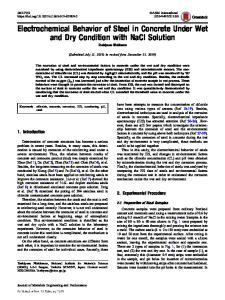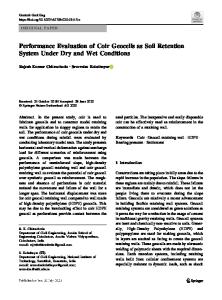Study on failure of red clay slopes with different gradients under dry and wet cycles
- PDF / 4,833,633 Bytes
- 16 Pages / 595.276 x 790.866 pts Page_size
- 82 Downloads / 367 Views
ORIGINAL PAPER
Study on failure of red clay slopes with different gradients under dry and wet cycles Liu Yang 1,2 & Chen Kaisheng 2 & Lyu Mengfei 2 & Wang Yingchao 1,3 Received: 15 March 2019 / Accepted: 27 April 2020 # Springer-Verlag GmbH Germany, part of Springer Nature 2020
Abstract In order to deeply study the failure mechanism of red clay slope engineering under the influence of gradients and natural environment, Guizhou red clay was chosen as the research object and two slope models with different gradients were established respectively. The indoor dry-wet cycle test of the red clay slope was conducted. With the finite element software, this study examined the evolution of slope displacement, moisture content, and pore water pressure with time at different angles. It also analyzed the failure modes of slopes at different angles. The results showed that: (1) the forms of slope failure were mainly splashing, surface erosion and gully, and the slope failure was caused by the combination of rainwater infiltration and runoff erosion; (2) under the same climatic conditions, when the slope became steeper, the influence of rain infiltration and sunshine was greater. Besides, there was an increase in the overall value of the moisture content, pore water pressure, and amplitude of variation. Furthermore, the internal soil strength decreased, while the horizontal displacement accelerated exponentially; and (3) no obvious sliding surface was found during the test. The displacement increased from the crest of the slope to the toe of the slope. The collapse began to occur from the toe of the slope, and the coalescence of multiple disintegrations caused the landslide. Keywords Red clay slope . Dry and wet cycle . Moisture content . Displacement . Pore water pressure
Introduction The experiment is based on Guizhou red clay, which is widely distributed in China; red clay can be found in Guangxi, Guizhou, and Hunan provinces (Mu et al. 2016). Guizhou belongs to southwestern China and is located in the YunnanGuizhou Plateau, between 103° 36′~109° 35′ east longitude
* Chen Kaisheng [email protected] Lyu Mengfei [email protected] Wang Yingchao [email protected] 1
State Key Laboratory for Geomechanics and Deep Underground Engineering, China University of Mining & Technology, Xuzhou 221116, Jiangsu, China
2
School of Civil Engineering, Guizhou University, Guiyang 550025, China
3
School of Mechanics & Civil Engineering, China University of Mining & Technology, Xuzhou 221116, Jiangsu, China
and 24° 37′~29° 13′ north latitude, The landforms of the province can be broadly divided into four basic types: plateau, mountain, hill, and basin, of which 92.5% are mountainous and hilly. Guizhou has a warm and humid climate and is a subtropical humid monsoon climate. The temperature changes little. Usually, the average temperature of the coldest month (January) is above 3 to 6 °C, and the average temperature of the hottest month (July) is generally 22 to 25 °C. Most of the precipitation is concentrated from May to July, and the
Data Loading...











